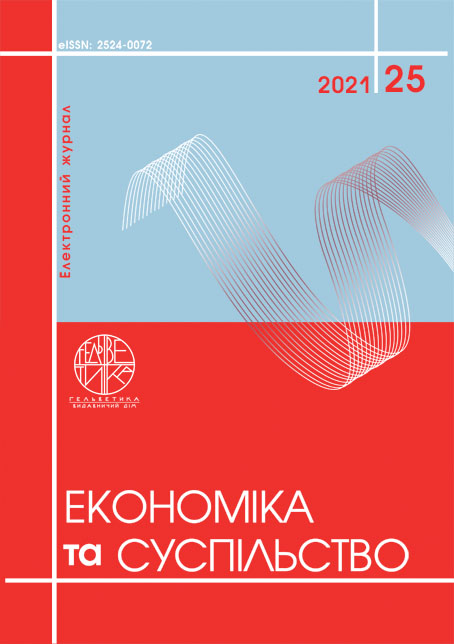THEORETICAL BASIS AND CLASSIFICATION OF RISKS TAKING INTO ACCOUNT THE FEATURES OF THE FUNCTIONING OF AGRICULTURAL SECTOR ENTERPRISES
Abstract
Currently, the agricultural sector has the most risky area of activity. The risks of agricultural enterprises are the subject of scientific research, as they have a huge impact not only on the activities of economic entities, but also on the food security of the state as a whole. Conditions for the functioning and development of agricultural enterprises are quite specific, which are not typical of other industries, it is dependent on natural conditions, seasonality of production, the complexity of innovation, regional, sectorial, functional, technological, organizational factors and features of living organisms in the production process. It should be noted that in the domestic and foreign economic literature there are mostly general principles of management of enterprises and production in conditions of uncertainty and risk. Despite the significant number, thoroughness and complexity of the research, some issues focused on the development of effective tools and mechanisms for predicting the risks of their classification in the operation and development of agricultural enterprises in the economic literature have not received unequivocal opinions. This is what determined the choice of tasks and purpose of this study. The article examines the components of risk in the agricultural sector of Ukraine's economy, analyzes the parameters of business by type of economic activity, and develops an author's approach to the classification of risks taking into account the specific conditions of agricultural enterprises. The conceptual apparatus of the terminology of the chosen topic is thoroughly analyzed. The factors that determine the risk in the economic activity of agricultural enterprises are analyzed and generalized. The authors identify the features of the risk management process in the context of enterprise management, its components. The original classification of risks faced by agricultural enterprises in the course of their economic activity is presented. It is concluded that the proposed classification may be of practical interest to economic entities and can be used as a model to create their own qualification table taking into account the sectorial characteristics of agricultural production and become one of the tools for management decisions to build an effective risk management system of enterprise.
References
Танклевська Н. С., Кириченко Н. В. Активізація та ефективність впровадження інновацій аграрними підприємствами : монографія. Херсон : Грінь Д.С., 2015. 216 с.
Найт Ф. Риск, неопределенность и прибыль: Пер. с англ. Москва : Дело, 2003. 360 с.
Вітлінський В. В., Веливоіваненко Г. І. Ризикологія в економіці та підприємництві : монографія. Київ : КНЕУ, 2004. 480 с.
Гранатуров В. М., Литовченко И. В. Управление предпринимательскими рисками: вопросы теории и практики. Одесса : МУП Эвен, 2005. 204с.
Клименко С. М., Дуброва О. С. Обгрунтування господарських рішень та оцінка ризиків : навч. посіб. Київ : КНЕУ, 2005. 252 с.
Дем’яненко М. Я. Фінансова криза в аграрному секторі АПК. Економічні науки. Cерія. Облік і фінанси. 2010. № 7 (1). С. 408–414.
Гросул В. А. Механізм управління антикризовою стійкістю підприємства на основі методології когнітивного моделювання. Economic efficiency of business in the conditions of unstable economy: Collective monograph. – Aspekt Publishing, Taunton, MA, United States of America, 2015. Р. 37–45.
Єпіфанова І. Ю. Сутність антикризового управління підприємства. Економіка та суспільство. 2016. №2. С. 265–269.
Макаренко І. О. Алгоритм антикризового управління підприємством. Актуальні проблеми економіки. 2005. № 3. С. 104–109.
Терещенко О. О. Інститут фінансового контролінгу – інноваційна платформа для корпоративних фінансів і контролінгу. Бухгалтерський облік і аудит. 2014. № 5. С. 52–53.
Андрушко О. Б. Аналіз моделей діагностики кризового стану та загрози банкрутства підприємства. Вісник Національного університету «Львівська політехніка»: Збірник наук. Праць Менеджмент та підприємництво в Україні: етапи становлення і проблеми розвитку. 2005. № 547. С. 9–21.
Цапко К. О. Дослідження наукових підходів до визначення та оцінки кризового стану підприємства. Управління розвитком. 2012. № 2. С. 173–176.
Бабіна Н. О. Антикризовий фінансовий контролінг як фактор забезпечення економічної безпеки підприємства. Ефективна економіка: електронне наукове фахове видання. № 5. 2014. URL: http://www.economy.nayka.com.ua
Tanklevska N.S. and Kyrychenko N.V. (2015), Aktyvizatsiia ta efektyvnist vprovadzhennia innovatsij ahrarnymy pidpryiemstvamy [Activation and efficiency of introduction of innovations by agrarian enterprises: monograph]. Hrin D.S. Kherson, Ukraine.
Najt F. (2003), Risk, neopredelennost i pribyl [Risk, uncertainty and reward]. Delo. Moskov. Russia.
Vitlinskyj V.V. and Velyvoivanenko H.I. (2004), Ryzykolohiia v ekonomitsi ta pidpryiemnytstvi [Riscology in economics and business]. KNEU. Kyiv. Ukraine.
Granaturov V.M. and Litovchenko I.V. (2005), Upravlenie predprinimatelskimi riskami: voprosy teorii i praktiki [Business risk management: theory and practice]. MUP Jeven. Odessa. Ukraine.
Klymenko S.M. and Dubrova O.S. (2005), Obhruntuvannia hospodarskykh rishen ta otsinka ryzykiv: navch.posib. [Establishment of state solutions and assessment of risiks]. KNEU. Kyiv. Ukraine.
Demianenko M. Ya. (2010). “Financial crisis in the agrarian sector of the agro-industrial complex”, Ekonomichni nauky. Ceriia Oblik i finansy. vol. 7 (1), pp. 408–414.
Hrosul V.A. (2015), Mekhanizm upravlinnia antykryzovoiu stijkistiu pidpryiemstva na osnovi metodolohii kohnityvnoho modeliuvannia. [Economic efficiency of business in the conditions of unstable economy: Collective monograph]. Aspekt Publishing, Taunton, MA, United States of America.
Yepifanova I. Yu. (2016), “The essence of the anti-crisis management of the enterprise”. Ekonomika ta suspilstvo, vol. 2, pp. 265-269.
Makarenko I. O. (2005), “Algorithm for anti-crisis management of an enterprise”. Aktualni problemy ekonomiky, vol. 3, pp. 104–109.
Tereschenko O. O. (2014), “Institute of Financial Control - an innovative platform for corporate finance and control”. Bukhhalterskyj oblik i audyt, vol. 5, pp. 52–53.
Andrushko O. B. (2005), “ Analysis of models for diagnostics of a crisis stagnation and contamination of bankruptcy of an enterprise”. Visnyk Natsionalnoho universytetu «Lvivska politekhnika»: Zbirnyk nauk. Prats Menedzhment ta pidpryiemnytstvo v Ukraini: etapy stanovlennia i problemy rozvytku, vol. 547. pp. 9–21.
Tsapko K. O. (2012), “Research of scientific approaches to the definition and assessment of the crisis of the enterprise”. Upravlinnia rozvytkom, vol. 2, pp. 173–176.
Babina N. O. (2014), “Anti-crisis financial controlling as a factor in ensuring the economic security of the enterprise”. Efektyvna ekonomika: elektronne naukove fakhove vydannia, vol. 5. URL: http://www.economy.nayka.com.ua


